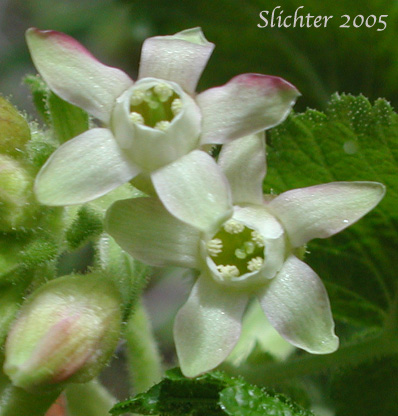
 The
photos above and at right show the creamy colored and pink flowered forms of sticky
currant from the southern slopes of Mt. Adams.......mid May 2005.
The
photos above and at right show the creamy colored and pink flowered forms of sticky
currant from the southern slopes of Mt. Adams.......mid May 2005.
Sticky currant is an unarmed shrub from 1-3 meters high with an aromatic odor. Its growth habit is erect to spreading, and it is often rather straggly. The young stems are hairy and glandular, aging to reddish-brown and glaucous. The bark often shreds. The leaves are orbicular to kidney-shaped with a shallow to deeply heart-shaped base, usually with 5 lobes, the lobes lined with coarsely toothed margins. They essentially look like miniature maple leaves. The blades are covered with soft, sticky hairs on both surfaces and measure 2.5-7.5 cm across. The petioles are densely glandular-hairy.
The inflorescence is a more or less drooping (spreading, drooping, or arching from the leaf axils) raceme of 3-13 bell-shaped flowers. The racemes measure 3-13 cm long. The flowers are each 2 cm long. The calyx is a cylindrical tube with 5 erect, greenish-yellow lobes. The 5 petals are cream-colored and 2.5-4 mm long. The fruit is a black, glandular berry without a bloom and from 8-11 mm long..
The plants are an alternate host for white pine blister rust (plant disease) The plants are berries are not palatable to animals nor humans. The plants are among the first shrubs which are found in clearcuts and burnt areas at higher elevations.
Sticky currant is found on moist, warm and moist, and cool sites in grand and subalpine fir (subalpine coniferous forest) plant communities.
Sticky currant is found from British Columbia south to the east of the crest of the Cascades to California, and eastward to southwestern Alberta, Montana and Colorado.
In the Columbia River Gorge, it may be found between the elevations of 3400'-4400' between the Wind River and Hood River, OR.